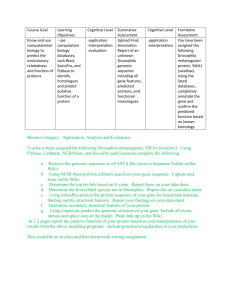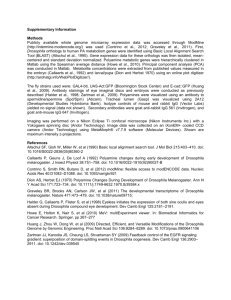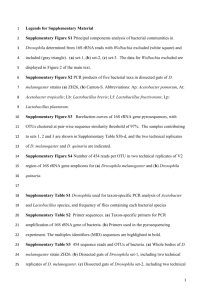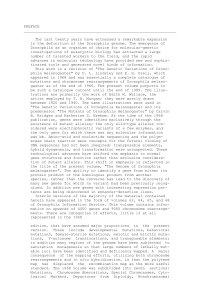Supp. Literature Cited
advertisement
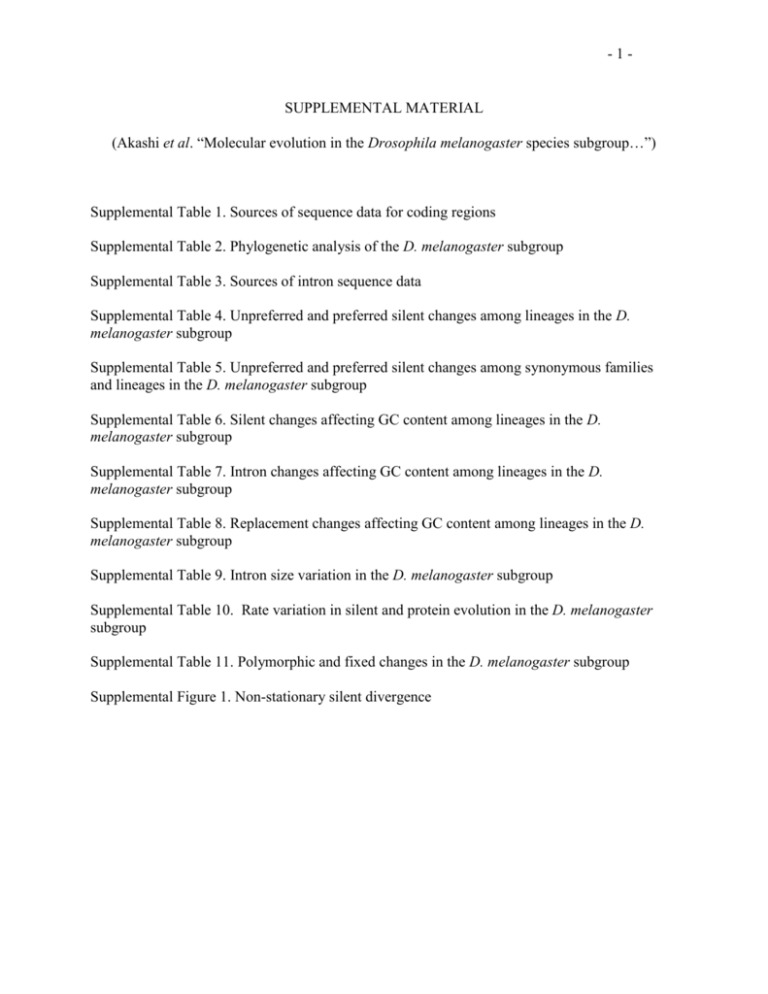
-1SUPPLEMENTAL MATERIAL (Akashi et al. “Molecular evolution in the Drosophila melanogaster species subgroup…”) Supplemental Table 1. Sources of sequence data for coding regions Supplemental Table 2. Phylogenetic analysis of the D. melanogaster subgroup Supplemental Table 3. Sources of intron sequence data Supplemental Table 4. Unpreferred and preferred silent changes among lineages in the D. melanogaster subgroup Supplemental Table 5. Unpreferred and preferred silent changes among synonymous families and lineages in the D. melanogaster subgroup Supplemental Table 6. Silent changes affecting GC content among lineages in the D. melanogaster subgroup Supplemental Table 7. Intron changes affecting GC content among lineages in the D. melanogaster subgroup Supplemental Table 8. Replacement changes affecting GC content among lineages in the D. melanogaster subgroup Supplemental Table 9. Intron size variation in the D. melanogaster subgroup Supplemental Table 10. Rate variation in silent and protein evolution in the D. melanogaster subgroup Supplemental Table 11. Polymorphic and fixed changes in the D. melanogaster subgroup Supplemental Figure 1. Non-stationary silent divergence -2- LITERATURE CITED (in supplemental materials) ALTSCHUL, S. F., W. GISH, W. MILLER, E. W. MYERS and D. J. LIPMAN, 1990 Basic local alignment search tool. J Mol Biol 215: 403-410. ARAKI, H., N. INOMATA and T. YAMAZAKI, 2001 Molecular evolution of duplicated amylase gene regions in Drosophila melanogaster: evidence of positive selection in the coding regions and selective constraints in the cis-regulatory regions. Genetics 157: 667-677. AYALA, F. J., and D. L. HARTL, 1993 Molecular drift of the bride of sevenless (boss) gene in Drosophila. Mol Biol Evol 10: 1030-1040. COMERON, J. M., and M. KREITMAN, 2000 The correlation between intron length and recombination in Drosophila. Dynamic equilibrium between mutational and selective forces. Genetics 156: 1175-1190. EANES, W. F., M. KIRCHNER, J. YOON, C. H. BIERMANN, I. N. WANG et al., 1996 Historical selection, amino acid polymorphism and lineage-specific divergence at the G6pd locus in Drosophila melanogaster and D. simulans. Genetics 144: 1027-1041. FELSENSTEIN, J., 1981 Evolutionary trees from DNA sequences: a maximum likelihood approach. J Mol Evol 17: 368-376. FELSENSTEIN, J., 1985 Confidence limits on phylogenies: An approach using the bootstrap. Evolution 39: 783-791. FITCH, W. M., 1971 Towards defining the course of evolution: Minimum change for a specific tree topology. Syst Zool 20: 406-416. HENDY, M. D., and D. PENNY, 1982 Branch and bound algorithms to determine minimal evolutionary trees. Mathematical Biosciences 59: 277-290. LONG, M., and C. H. LANGLEY, 1993 Natural selection and the origin of jingwei, a chimeric processed functional gene in Drosophila. Science 260: 91-95. MCDONALD, J. H., and M. KREITMAN, 1991 Adaptive protein evolution at the Adh locus in Drosophila. Nature 351: 652-654. MOUNT, S. M., C. BURKS, G. HERTZ, G. D. STORMO, O. WHITE et al., 1992 Splicing signals in Drosophila: intron size, information content, and consensus sequences. Nucleic Acids Res 20: 4255-4262. SAITOU, N., and M. NEI, 1987 The neighbor-joining method: a new method for reconstructing phylogenetic trees. Mol Biol Evol 4: 406-425. STEPHAN, W., V. S. RODRIGUEZ, B. ZHOU and J. PARSCH, 1994 Molecular evolution of the metallothionein gene Mtn in the melanogaster species group: results from Drosophila ananassae. Genetics 138: 135-143. SUMNER, C., 1991 Nucleotide polymorphism in the Alcohol dehydrogenase Duplicate locus of Drosophila simulans: implications for the neutral theory. Undergraduate thesis. Princeton University, Princeton, NJ. SWOFFORD, D. L., 2003 PAUP*. Phylogenetic Analysis Using Parsimony (*and Other Methods). Sinauer Associates, Sunderland, Massachusetts. TAMURA, K., and M. NEI, 1993 Estimation of the number of nucleotide substitutions in the control region of mitochondrial DNA in humans and chimpanzees. Mol Biol Evol 10: 512526. YANG, Z., 1994 Maximum likelihood phylogenetic estimation from DNA sequences with variable rates over sites: approximate methods. J Mol Evol 39: 306-314.



